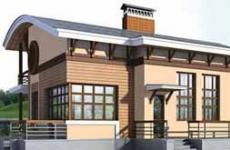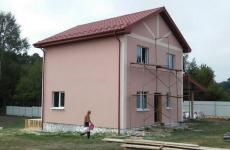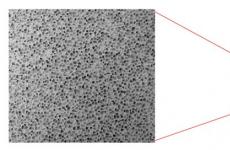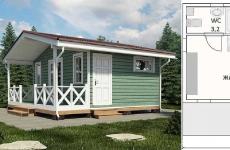Automatic pressure maintenance systems manufactured by Anton Eder GmbH in modern heating systems. Booster pumping stations for increasing pressure aupd based on boosta pumps for automatic water supply, fire extinguishing Aupd for supporting
A. Bondarenko
The use of automatic pressure maintenance units (AUPD) for heating and cooling systems has become widespread due to the active growth in high-rise construction.
AUPD perform the functions of maintaining constant pressure, compensation for thermal expansion, deaeration of the system and compensation for heat carrier losses.
But since it's fairly new to Russian market equipment, many specialists in this field have questions: what are standard AUPD, what is the principle of their operation and the selection method?
Let's start with a description of the default settings. Today, the most common type of AUPD is installations with a pump-based control unit. Such a system consists of a non-pressure expansion tank and a control unit, which are interconnected. The main elements of the control unit are pumps, solenoid valves, a pressure sensor and a flow meter, and the controller, in turn, controls the AUPD as a whole.
The principle of operation of these AUPDs is as follows: when heated, the coolant in the system expands, which leads to an increase in pressure. The pressure sensor detects this increase and sends a calibrated signal to the control unit. The control unit (with the help of a weight (filling) sensor that constantly records the values of the liquid level in the tank) opens the solenoid valve on the bypass line. And through it, excess coolant flows from the system to the membrane expansion tank where the pressure is equal to atmospheric pressure.
Upon reaching the set pressure in the system, the solenoid valve closes and shuts off the flow of fluid from the system to the expansion tank. When the coolant in the system cools, its volume decreases, and the pressure drops. If the pressure drops below the set level, the control unit turns on the pump. The pump runs until the pressure in the system rises to the set value. Constant monitoring of the water level in the tank protects the pump from running dry and also prevents the tank from overflowing. If the pressure in the system goes beyond the maximum or minimum, one of the pumps or solenoid valves, respectively, is activated. If the performance of one pump in the pressure line is not enough, the second pump is activated. It is important that this type of AUPD has a safety system: if one of the pumps or solenoids fails, the second one should automatically turn on.
It makes sense to consider the methodology for selecting AUPD based on pumps using an example from practice. One of the recently implemented projects is the Residential Building on Mosfilmovskaya (a facility of the DON-Stroy company), in the central heating point which such pumping unit. The height of the building is 208 m. Its CHP consists of three functional parts responsible, respectively, for heating, ventilation and hot water supply. The heating system of the high-rise building is divided into three zones. Total settlement thermal power heating systems - 4.25 Gcal/h.
We present an example of the selection of AUPD for the 3rd heating zone.
Initial data required for calculation:
1) thermal power of the system (zones) N system, kW. In our case (for the 3rd heating zone), this parameter is equal to 1740 kW (initial data of the project);
2) static height H st (m) or static pressure R st (bar) is the height of the liquid column between the installation connection point and highest point system (1 m liquid column = 0.1 bar). In our case, this parameter is 208 m;
3) volume of coolant (water) in the system V, l. For the correct selection of AUPD, it is necessary to have data on the volume of the system. If exact value is unknown, the average value of the water volume can be calculated from the coefficients given in table. According to the project, the water volume of the 3rd heating zone V syst is equal to 24,350 liters.
4) temperature graph: 90/70 °C.

First stage. Calculation of the volume of the expansion tank to AUPD:
1. Calculation of expansion coefficient TO ext (%), expressing the increase in the volume of the coolant when it is heated from the initial to the average temperature, where T cf \u003d (90 + 70) / 2 \u003d 80 ° С. At this temperature, the expansion coefficient will be 2.89%.
2. Calculation of expansion volume V exp (l), i.e. the volume of coolant displaced from the system when it is heated to an average temperature:
V ext = V syst. K ext /100 = 24350 . 2.89 / 100 \u003d 704 liters.
3. Calculation of the estimated volume of the expansion tank V b:
V b = V ext. TO zap = 704 . 1.3 \u003d 915 liters.
where TO zap - safety factor.
Next, we select the standard size of the expansion tank from the condition that its volume should not be less than the calculated one. If necessary (for example, when there are restrictions on dimensions), the AUPD can be supplemented with an additional tank, dividing the total estimated volume in half.
In our case, the volume of the tank will be 1000 liters.
Second phase. Control unit selection:
1. Determining the rated working pressure:
R syst = H syst /10 + 0.5 = 208/10 + 0.5 = 21.3 bar.
2. Depending on the values R system and N syst choose the control unit according to special tables or diagrams provided by suppliers or manufacturers. All models of control units can include one or two pumps. In the AUPD with two pumps in the installation program, you can optionally select the pump operation mode: “Primary / standby”, “Alternate pump operation”, “Pump parallel operation”.
This completes the calculation of the AUPD, and the volume of the tank and the marking of the control unit are prescribed in the project.
In our case, the AUPD for the 3rd heating zone should include a non-pressure tank with a volume of 1000 liters and a control unit that will ensure that the pressure in the system is maintained at least 21.3 bar.
For example, for this project, an AUPD MPR-S / 2.7 was chosen for two pumps, PN 25 bar and an MP-G 1000 tank from Flamco (Netherlands).
In conclusion, it is worth mentioning that there are also installations based on compressors. But that's a completely different story...
Article provided by ADL Company
The development of large cities inevitably leads to the need to build high-rise multifunctional office and retail complexes. Such high-rise buildings present special requirements to water heating systems.
Many years of experience in the design and operation of multifunctional buildings allows us to formulate the following conclusion: the basis for the reliability and efficiency of the overall operation of the heating system is compliance with the following technical requirements:
- The constancy of the coolant pressure in all modes of operation.
- permanence chemical composition coolant.
- Absence of gases in free and dissolved form.
Failure to comply with at least one of these requirements leads to increased wear of heat engineering equipment (radiators, valves, thermostats, etc.). In addition, the consumption of thermal energy increases, and, accordingly, material costs increase.
These requirements can be met by pressure maintenance, automatic make-up and degassing systems from Anton Eder GmbH.
Rice. 1. Scheme of an Eder pressure maintenance plant
Equipment "Eder" (EDER) consists of separate modules that provide pressure maintenance, make-up and degassing of the coolant. Coolant pressure maintaining module A consists of an expansion tank 1, in which an elastic chamber 2 is located, which prevents the coolant from contacting with air and directly with the tank walls, which distinguishes Eder expansion units from membrane-type expanders, in which the tank walls are subject to corrosion due to for contact with water. With an increase in pressure in the system, caused by the expansion of water during heating, valve 3 opens, and excess water from the system enters the expansion tank. When cooling and, accordingly, the volume of water in the system decreases, pressure sensor 4 is activated, which includes pump 5, which pumps the coolant from the tank into the system until the pressure in the system becomes equal to the specified one.
Make-up module B allows you to compensate for the loss of coolant in the system resulting from different kind leaks. When the water level in tank 1 decreases and the preset minimum value valve 6 opens and water from the cold water supply system enters the expansion tank. When the level set by the user is reached, the valve turns off and the make-up stops.
During the operation of heating systems in high-rise buildings, the most acute issue is the degassing of the coolant. Existing air vents make it possible to get rid of the “airiness” of the system, but do not solve the problem of water purification from gases dissolved in it, primarily atomic oxygen and hydrogen, which cause not only corrosion, but also cavitation at high speeds and pressures of the coolant, which destroys the system devices: pumps , valves and fittings. When using modern aluminum radiators at the expense chemical reaction hydrogen is formed in water, the accumulation of which can lead to a rupture of the radiator housing, with all the “consequences” that follow from this.
The Eder degassing module C uses physical way continuous removal of dissolved gases due to a sharp decrease in pressure. When the valve 9 is briefly opened in a given volume (approx. 200 l) 8 within a fraction of a second, the water pressure exceeding 5 bar drops to atmospheric pressure. In this case, there is a sharp release of gases dissolved in water (the effect of opening a bottle of champagne). A mixture of water and gas bubbles is fed into the expansion tank 1. The degassing tank 8 is replenished from the expansion tank 1 with water that has already been degassed. Gradually, the entire volume of the coolant in the system will be completely cleaned of impurities and gases. The higher the static height of the heating system, the higher the requirements for degassing and constant pressure of the heat carrier. All these modules are controlled microprocessor unit D, having diagnostic functions and the possibility of inclusion in the automated systems dispatching.
The use of Eder installations is not limited to high-rise buildings. It is advisable to use them in buildings with an extensive heating system. Compact EAC units, in which an expansion vessel with a volume of up to 500 l is articulated with a control cabinet, can be successfully used as a supplement to autonomous systems heating in individual construction.
The company's installations, successfully operating in all high-rise buildings in Germany, are a choice in favor of modern engineering system heating.
Pressure boosting units are pumping stations, which include from 2 to 4 multistage vertical pumps Boosta.
Boosta pumps are mounted on a common frame and connected to each other by suction and pressure pipes. Connection of pumps to manifolds is carried out using stop valves and check valves.
The control cabinet is mounted on a rack mounted on the frame.
Pressure booster systems have different control methods:
- AUPD … Boosta … CR with several frequency converters.
Booster units with 2÷4 Boosta pumps, each pump is connected to a separate frequency converter. All pumps operate at variable speed, at the same speed. - AUPD ... Boosta ... KCHR with cascade-frequency control.
Booster units with 2÷4 Boosta pumps, only one pump is equipped with a frequency converter. The remaining pumps are activated depending on the requirements of the system and operate at constant speed.
Maintaining a constant pressure is ensured by regulating the speed of the pump to which the frequency converter is connected.
Flamcomat automatic pressure maintenance system (pump control)
Application area
AUPD Flamcomat is used to maintain constant pressure, compensate for thermal expansion, deaeration and compensation for coolant losses in closed systems heating or cooling.
*If the temperature of the system at the connection point of the unit exceeds 70 °C, it is necessary to use an intermediate tank Flexcon VSV, which provides cooling of the working fluid before installation (see chapter "Intermediate tank VSV").
Purpose of the Flamcomat installation
Maintain pressure
AUPD Flamcomat maintains the required pressure in
system in a narrow range (± 0.1 bar) in all operating modes, and also compensates for thermal expansion
coolant in heating or cooling systems.
In the standard version, the AUPD Flamcomat
consists of the following parts:
. membrane expansion tank;
. Control block;
. tank connection.
Water and air in the tank are separated by a replaceable membrane made of high quality butyl rubber, which is characterized by very low gas permeability.
Operating principle
When heated, the coolant in the system expands, which leads to an increase in pressure. The pressure sensor detects this increase and sends a calibrated signal to the
Control block. The control unit, which, using a weight sensor (filling, Fig. 1), constantly records the values of the liquid level in the tank, opens the solenoid valve on the bypass line, through which excess coolant flows from the system to the membrane expansion tank (the pressure in which is equal to atmospheric).
Upon reaching the set pressure value in the system, the solenoid valve closes and shuts off the flow of fluid from the system to the expansion tank.

When the coolant in the system cools, its volume decreases and the pressure drops. If the pressure falls below the set level, the control unit turns on
pump. The pump runs until the pressure in the system rises to the set level.
Constant monitoring of the water level in the tank protects the pump from running dry and also prevents the tank from overflowing.
If the pressure in the system goes beyond the maximum or minimum, then, respectively, one of the pumps or one of the solenoid valves is activated.
If there is not enough performance of 1 pump in the pressure line, then the 2nd pump will be activated (control unit D10, D20, D60 (D30), D80, D100, D130). AUPD Flamcomat with two pumps has a safety system: if one of the pumps or solenoids fails, the second one automatically turns on.
In order to equalize the operating time of pumps and solenoids during the operation of the installation and increase the service life of the installation as a whole, in two-pump installations,
"work-standby" switching system between pumps and solenoid valves (daily).
Error messages regarding pressure value, tank fill level, pump operation and solenoid valve operation are displayed on the control panel of the SDS module.
Deaeration


Deaeration in the Flamcomat AUPD is based on the principle of pressure reduction (throttling, Fig. 2). When a pressurized coolant enters the expansion tank of the installation (non-pressure or atmospheric), the ability of gases to dissolve in water is reduced. Air is released from the water and removed through an air vent installed in the upper part of the tank (Fig. 3). To remove as much air from the water as possible, a special compartment with
PALL rings: this increases the deaeration capacity by 2-3 times compared to conventional installations.
In order to remove as many excess gases from the system as possible, an increased number of cycles, as well as increased time cycles (both values depend on the size of the tank) are pre-set in the factory setting. After 24-40 hours, this mode of turbo deaeration changes to normal deaeration mode.
If necessary, you can start or stop the turbo-deaeration mode manually (if you have SDS-module 32).
make-up
Automatic make-up compensates for the loss of coolant volume due to leakage and deaeration.
The level control system automatically activates the make-up function when required, and the coolant enters the tank in accordance with the program (Fig. 4).
When the minimum level of the heating medium in the tank is reached (usually = 6%), the solenoid on the make-up line opens.
The volume of coolant in the tank will be increased to required level(usually = 12%). This will prevent the pump from running dry.
When using a standard flow meter, the amount of water can be limited by the make-up time in the program. When this time is exceeded, action must be taken to correct the problem. After that, if the make-up time has not changed, the same volume of water can be added to the system.
In installations where pulse flowmeters (option) are used, the make-up will turn off when the programmed value is reached.
measured volume of water. If the feed line
AUPD Flamcomat will be connected directly to the drinking water supply system, it is necessary to install a filter and protection against reverse flow(hydraulic cut-off - option).
Main elements of AUPD Flamcomat
|
AUPD Flamcomat М0 GB 300






